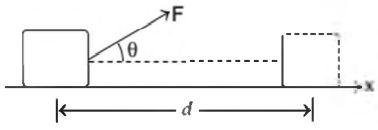Work
A farmer ploughing the field, a construction worker carrying bricks, a student studying for a competitive examination, an artist painting a beautiful landscape, all are said to be working. In physics, however, the word ‘Work’ covers a definite and precise meaning. Work refers to the force and the displacement over which it acts. Consider a constant force `F` acting on an object of mass `m`. The object undergoes a displacement `d` in the positive `x`-direction as shown in figure.

The work done by the force is defined to be the product of component of the force in the direction of the displacement and the magnitude of this displacement, thus `W=(F cos theta)d = F•d.`
A proton is kept at rest. A positively charged particle is released from rest at a distance `d` in its field. Consider two experiments; one in which the charged particle is also a proton and in another, a positron. In same time `t`, the work done on the two moving charged particles is
Options:
(a) same as the same force law is involved in the two experiments
(b) less for the case of a positron, as the positron moves away more rapidly and the force on it weakens
(c) more for the case of a positron, as the positron moves away a larger distance
(d) same as the work is done by charged particle on the stationary proton